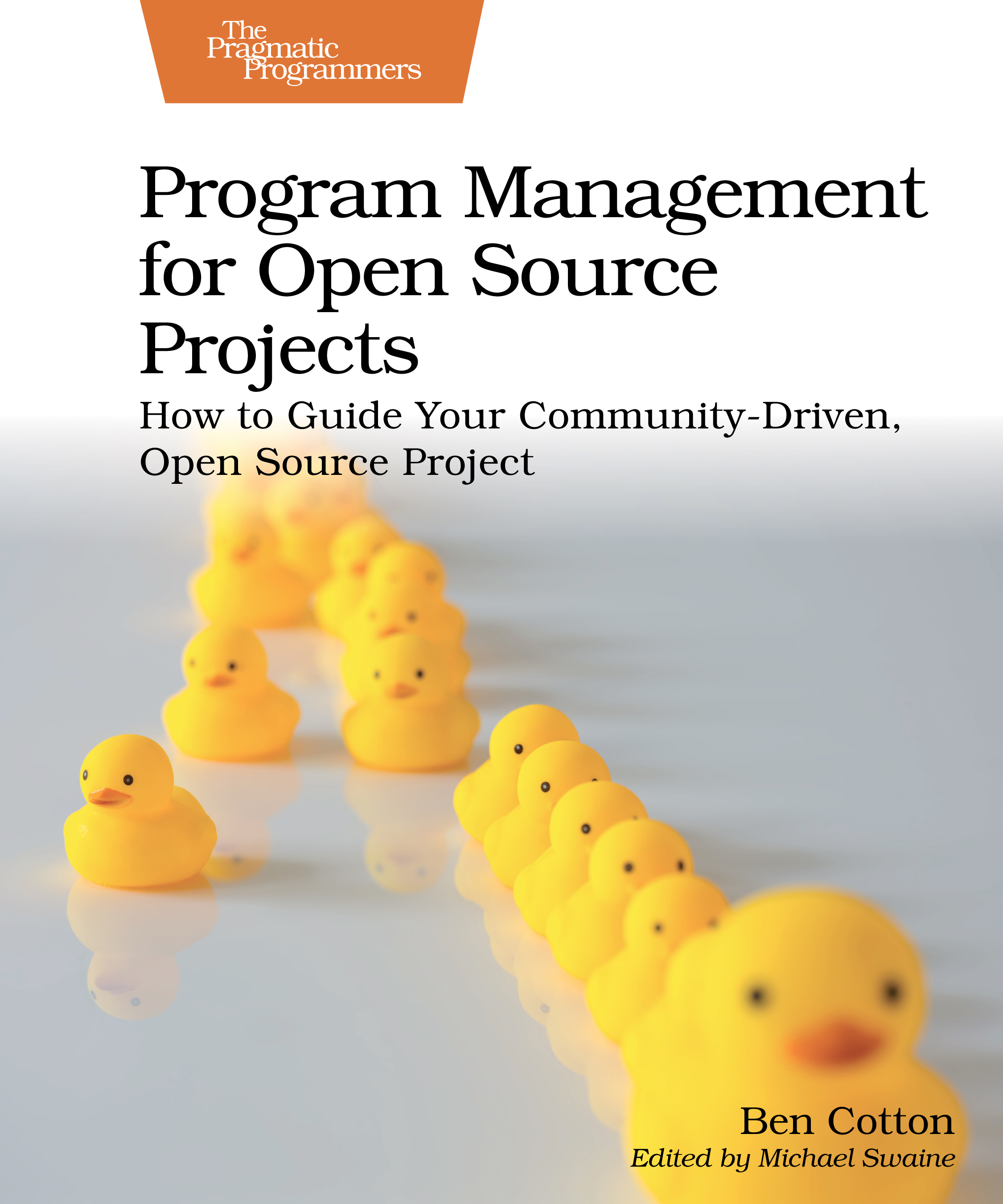Program Management for Open Source Projects
How to Guide Your Community-Driven, Open Source Project
by: Ben Cotton
| Published | 2022-07-22 |
|---|---|
| Internal code | bcosp |
| Print status | In Print |
| Pages | 190 |
| User level | Intermediate |
| Keywords | open source, free software, foss, linux, project management |
| Related titles |
|
| ISBN | 9781680509243 |
| Other ISBN |
Channel epub: 9781680509946 Channel PDF: 9781680509953 Kindle: 9781680509922 Safari: 9781680509939 Kindle: 9781680509922 |
| BISACs | COM051430 COMPUTERS / Software Development & Engineering / Project ManagementBUS041000 BUSINESS & ECONOMICS / ManagementBUS041000 BUSINESS & ECONOMICS / Management |
Highlight
Every organization develops a bureaucracy, and open source projects are no exception. When your structure is intentional and serves the project, it can lead to a successful and predictable conclusion. But project management alone won’t get you there. Take the next step to full program management. Become an expert at facilitating communication between teams, managing schedules and project lifecycle, coordinating a process for changes, and keeping meetings productive. Make decisions that get buy-in from all concerned. Learn how to guide your community-driven open source project with just the right amount of structure.
Description
Bureaucratic processes naturally develop in large organizations, and open source projects are no different. The trick is to keep the processes intentional and in service of the project. That’s program management and you have probably been doing it even if you don’t have that title. Make your open source projects successful, predictable, and enjoyable by applying the principles and skills of program management in this book.
See how program management differs from project management. Build trust and credibility by building relationships, sharing information, and communicating effectively. Construct efficient decision-making and governance structures, with openness and clear responsibilities. Conduct more effective and enjoyable meetings. Hold the right kind of meeting for the matters to be discussed: text, phone, video, or face-to-face. Develop release lifecycles, including release planning, schedules, and go/no-go decisions, and keep on schedule. Create and manage an effective changes process. Use your bug tracker to better understand and manage the bugs and feature requests of your project. Make decisions that get buy-in from all concerned.
Develop processes that serve your open source project instead of making the project serve the process.
Contents and Extracts
- Introduction
- What a Program Manager Does
- Why Program Management Is Important
- Why You Want This Book
- Manage the Program
- Take the Big Picture View
- Balance Priorities
- Manage Risks
- Report Status
- Do Everything
- Manage Single Points of Failure and Burnout
- Retrospective
- Zoom in on Projects
- Define “Project”
- Find the Balance
- Know the Artifacts
- Retrospective
- Communicate and Build Relationships
- Build Relationships
- Communicate
- Retrospective
- Make Good Decisions
- Define the Question
- Give a Voice
- Take a Vote
- Retrospective
- Design Suitable Processes
- Define the Context
- Build a Process
- Implement the Process
- Make Revisions
- Retrospective
- Hold Useful Meetings excerpt
- Why Bother?
- Schedule the Meeting
- Choose the Medium
- Make Your Meeting Productive
- Make Decisions in the Right Place
- Retrospective
- Develop Your Release Life Cycle
- Decide How Many
- Set the Phases
- Set the Length
- Retrospective
- Build a Release Schedule
- A Schedule’s Purpose
- Choose a Schedule Model
- Define “Done”
- Add Milestones
- Manage Conflicts
- Keep the Schedule Accurate
- Communicate the Schedule
- Retrospective
- Manage Features excerpt
- Create a Template
- Set the Scale
- Set the Approval Process
- Create the Timeline
- Define the Life Cycle of a Proposal
- Shepherd the Proposals
- Retrospective
- Track and Triage Bugs excerpt
- Track Bugs
- Triage Bugs
- Prioritize Bugs
- Close Bugs
- Analyze Bugs
- Retrospective
- Ship the Release
- Set Release Criteria
- Freeze the Code
- Produce Release Candidates
- Determine Readiness
- Make the Decision
- Retrospective
- Choose Your Tools
- Identify Your Requirements
- Pick Your Tools
- Retrospective
